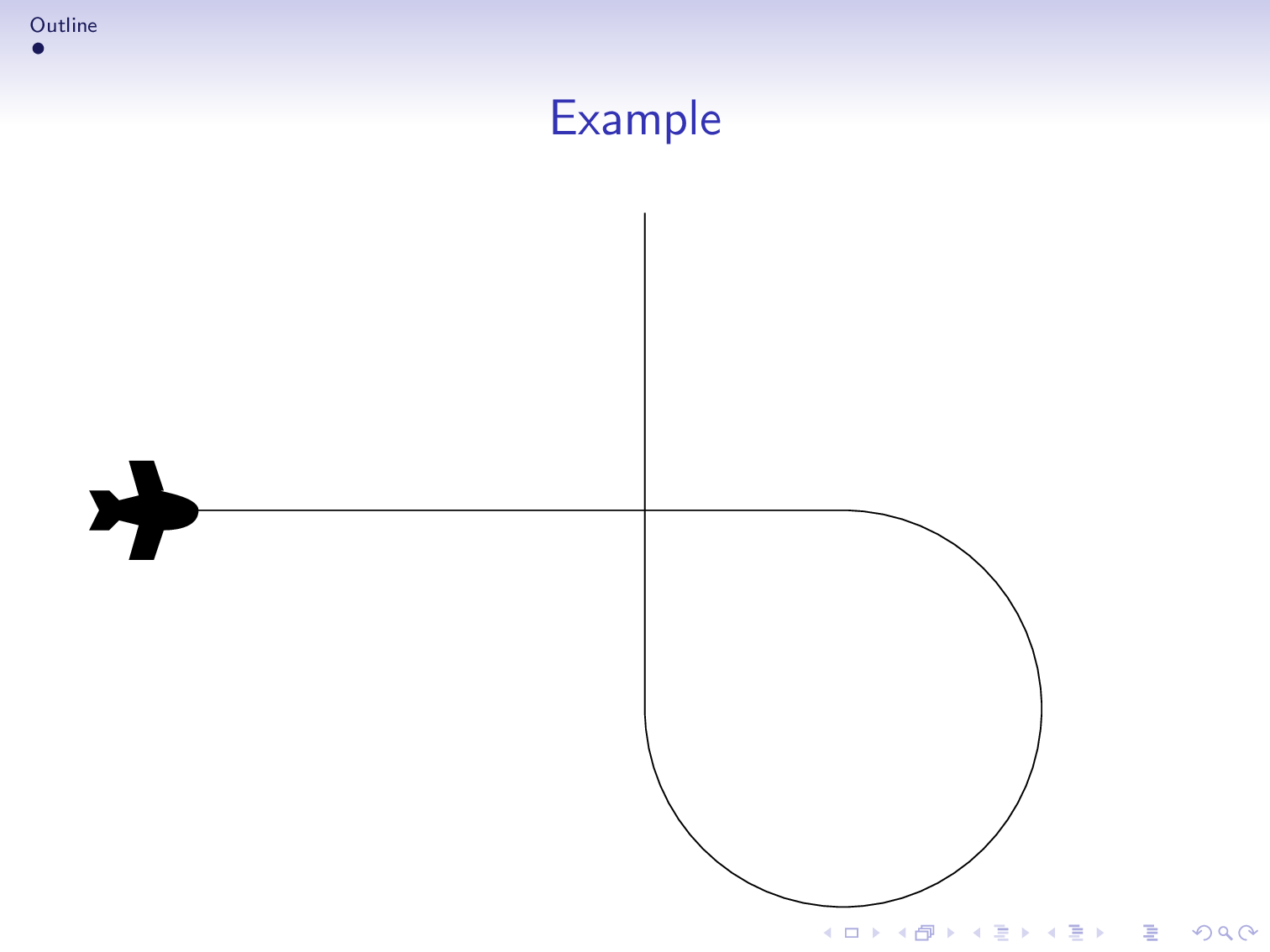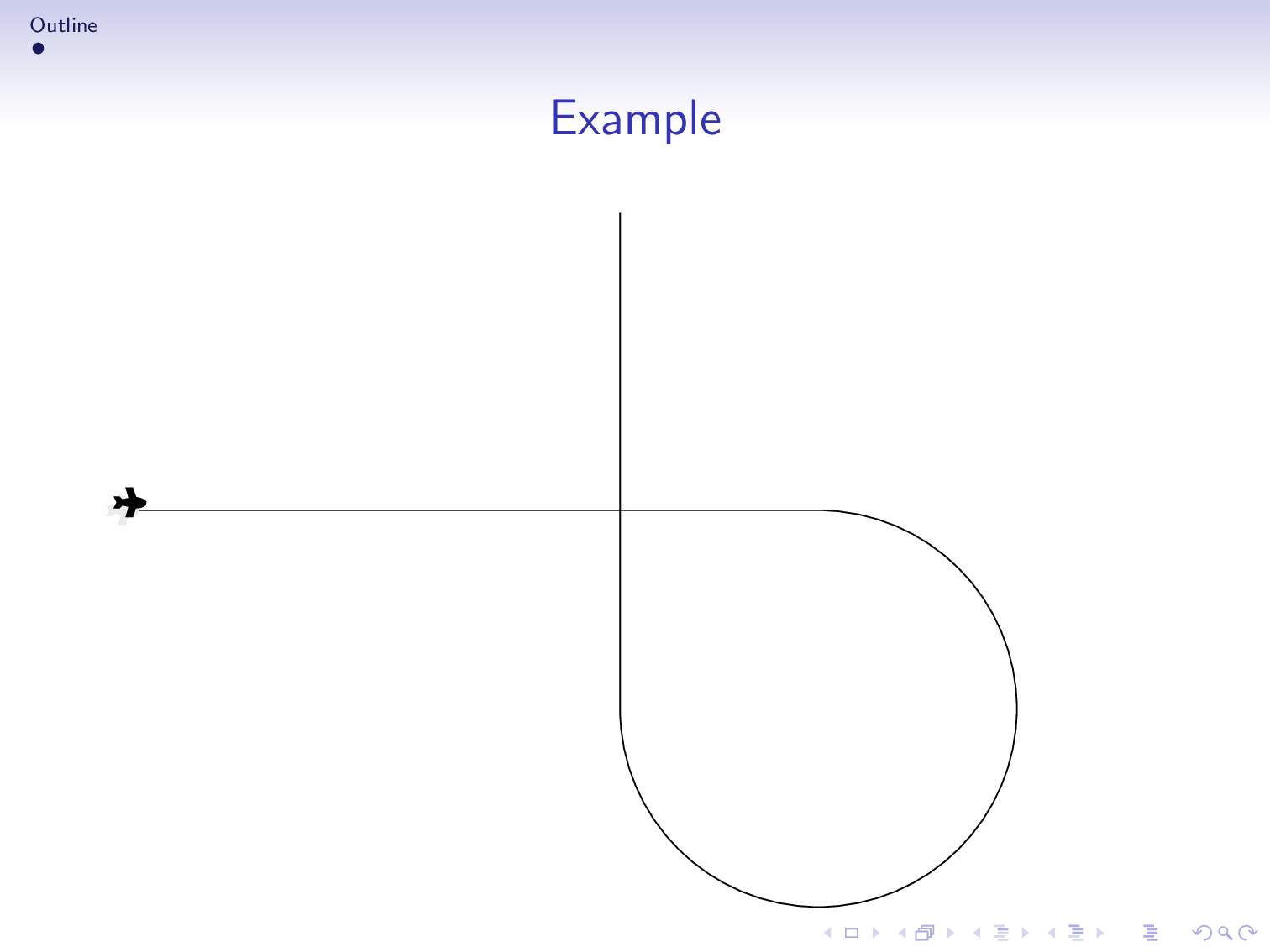
Für meine (Beamer-)Präsentation (zum Thema Flugzeuge) möchte ich eine Animation eines Flugzeugs. Ich hoffe, es gibt eine Möglichkeit, das Flugzeug über den Bildschirm zu bewegen (oder jede andere Bewegung ist auch möglich). Siehe zum Beispiel 09:45 in diesem VideoBewegendes Flugzeug in PowerpointDas Flugzeug kann aussehen wieDas, Sie können gerne jedes beliebige Flugzeugbild einfügen.
Das ist alles, was ich im Moment habe (ein einfaches Bild eines Flugzeugs in einer Beamer-Vorlage)
\documentclass[ignorenonframetext]{beamer}
\usepackage{fontawesome}
\mode<presentation>
{\usetheme{Singapore}
\setbeamercovered{transparent}
}
\usepackage[english]{babel}
\title{Beamer Example}
\author{Author}
\subject{Presentation Programs}
\institute[ University]{
Department of XZ\\
University}
\begin{document}
\section{Outline}
\frame[label=exampleframe]{
\frametitle{Example}
\faPlane
}
\end{document}
Antwort1
Beispiel mit der Fontawesome-Ebene (klickenKlicken Sie auf das Bild, um die Animation zu sehen):
Aktualisieren: Der Beamer-Teil, um die Anfrage vollständig zu erfüllen.
Werdenunabhängig von AdobeProdukte kann die gesamte Präsentation im SVG-Format erfolgen (Klickenum die Präsentation zu starten,F11für Vollbild, navigieren Sie mitPgUpUndPgDown; für die korrekte Darstellung des Hintergrundverlaufs ist möglicherweise ein Blink-basierter Browser [Chromium, Chrome, Opera] erforderlich):
Eigenständige AnimationLaTeX-Eingabe:
Update: Beispiel erweitert (sanfterer Start und Landung) und verbessert (Knotenplatzierung entlang des Pfads, wie vom Benutzer @Hafid gezeigt).
\documentclass{standalone} % animated PDF
%\documentclass[dvisvgm,preview]{standalone} % animated SVG: latex + dvisvgm --font-format=woff --bbox=preview --zoom=-1
%\documentclass[export]{standalone} % multipage PDF
\usepackage{fontawesome}
\usepackage{tikz,animate}
\ExplSyntaxOn
\let\fpEval\fp_eval:n % expandable flt-point calculation with L3
\ExplSyntaxOff
\begin{document}
\begin{animateinline}[
autoplay,controls,
begin={\begin{tikzpicture}[scale=0.85]
\coordinate (a) at (110:15); \coordinate (b) at (70:15);
\node [anchor=north east] at (a) {A}; \node [anchor=north west] at (b) {B};
\useasboundingbox (a) node [anchor=north east] {A} arc [start angle=110,end angle=70,radius=15] (b) node [anchor=north west] {B};},
end={\end{tikzpicture}}
]{24}
\multiframe{161}{iPos=0+1}{%
\path[draw] (a) arc [start angle=110,end angle=70,radius=15] (b) node [pos=\fpEval{0.5*(1-cosd(180*\iPos/160))},sloped,rotate=-45]{\faPlane};
}
\newframe
\multiframe{19}{iAng=45+10}{%
\path[draw] (a) arc [start angle=110,end angle=70,radius=15] (b) node [pos=1,sloped,rotate=-\iAng]{\faPlane};
}
\newframe*
\multiframe{161}{iPos=0+1}{%
\path[draw] (a) arc [start angle=110,end angle=70,radius=15] (b) node [pos=\fpEval{0.5*(1+cosd(180*\iPos/160))},sloped,rotate=135]{\faPlane};
}
\newframe
\multiframe{19}{iAng=135+-10}{%
\path[draw] (a) arc [start angle=110,end angle=70,radius=15] (b) node [pos=0,sloped,rotate=\iAng]{\faPlane};
}
\end{animateinline}
\end{document}
Präsentation (beamer-Klasse)LaTeX-Eingabe. Kompilieren mit
latex presentation.tex
latex presentation.tex
dvisvgm --font-format=woff --bbox=papersize --zoom=-1 -p1,- presentation
\documentclass[dvisvgm,hypertex,aspectratio=169]{beamer}
\usetheme{Singapore}
\usepackage{fontawesome}
\usepackage{tikz,animate}
\ExplSyntaxOn
\let\fpEval\fp_eval:n % expandable flt-point calculation with L3
\ExplSyntaxOff
%%%%%%%%%%%%%%%%%%%%%%%%%%%%%%%%%%%%%%%%%%%%%%%%%%%%%%%%%%%%%%%%%%%%%%%%%%%%%%%
% PageDown, PageUp key event handling; navigation symbols
%%%%%%%%%%%%%%%%%%%%%%%%%%%%%%%%%%%%%%%%%%%%%%%%%%%%%%%%%%%%%%%%%%%%%%%%%%%%%%%
\usepackage[totpages]{zref}
\usepackage{atbegshi}
\usepackage{fontawesome}
\setbeamertemplate{navigation symbols}{}
\AtBeginShipout{%
\AtBeginShipoutAddToBox{%
\special{dvisvgm:raw
<defs>
<script type="text/javascript">
<![CDATA[
document.addEventListener('keydown', function(e){
if(e.key=='PageDown'){
\ifnum\thepage<\ztotpages
document.location.replace('\jobname-\the\numexpr\thepage+1\relax.svg');%
\fi
}else if(e.key=='PageUp'){
\ifnum\thepage>1
document.location.replace('\jobname-\the\numexpr\thepage-1\relax.svg');%
\fi%
}
});
]]>
</script>
</defs>
}%
}%
\AtBeginShipoutUpperLeftForeground{%
\raisebox{-\dimexpr\height+0.5ex\relax}[0pt][0pt]{\makebox[\paperwidth][r]{%
\normalsize\color{structure!40!}%
\ifnum\thepage>1%
\href{\jobname-\the\numexpr\thepage-1\relax.svg}{\faArrowLeft}%
\else%
\textcolor{lightgray}{\faArrowLeft}%
\fi\hspace{0.5ex}%
\ifnum\thepage<\ztotpages%
\href{\jobname-\the\numexpr\thepage+1\relax.svg}{\faArrowRight}%
\else%
\textcolor{lightgray}{\faArrowRight}%
\fi%
\hspace{0.5ex}%
}}%
}%
}%
%%%%%%%%%%%%%%%%%%%%%%%%%%%%%%%%%%%%%%%%%%%%%%%%%%%%%%%%%%%%%%%%%%%%%%%%%%%%%%%
\title{Fasten Seat Belts}
\subtitle{Use a Web browser and press \framebox{F11}}
\author{AlexG}
\date{\today}
\begin{document}
\frame{\titlepage}
\begin{frame}{Animation}
\begin{center}
\begin{animateinline}[
autoplay,controls,
begin={\begin{tikzpicture}[scale=0.95]
\coordinate (a) at (110:15); \coordinate (b) at (70:15);
\node [anchor=north east] at (a) {A}; \node [anchor=north west] at (b) {B};
\useasboundingbox (a) node [anchor=north east] {A} arc [start angle=110,end angle=70,radius=15] (b) node [anchor=north west] {B};},
end={\end{tikzpicture}}
]{24}
\multiframe{161}{iPos=0+1}{%
\path[draw] (a) arc [start angle=110,end angle=70,radius=15] (b) node [pos=\fpEval{0.5*(1-cosd(180*\iPos/160))},sloped,rotate=-45]{\faPlane};
}
\newframe
\multiframe{19}{iAng=45+10}{%
\path[draw] (a) arc [start angle=110,end angle=70,radius=15] (b) node [pos=1,sloped,rotate=-\iAng]{\faPlane};
}
\newframe*
\multiframe{161}{iPos=0+1}{%
\path[draw] (a) arc [start angle=110,end angle=70,radius=15] (b) node [pos=\fpEval{0.5*(1+cosd(180*\iPos/160))},sloped,rotate=135]{\faPlane};
}
\newframe
\multiframe{19}{iAng=135+-10}{%
\path[draw] (a) arc [start angle=110,end angle=70,radius=15] (b) node [pos=0,sloped,rotate=\iAng]{\faPlane};
}
\end{animateinline}
\end{center}
\end{frame}
\end{document}
Antwort2
Mit decorations.markingskönnen Sie das Flugzeug entlang eines beliebigen Pfades transportieren und es wird immer so gedreht, dass es eine Tangente des Pfades ist (ohne dass Sie das manuell tun müssen).
\documentclass[ignorenonframetext]{beamer}
\usepackage{fontawesome}
\mode<presentation>
{\usetheme{Singapore}
\setbeamercovered{transparent}
}
\usepackage[english]{babel}
\usepackage{tikz}
\usetikzlibrary{decorations.markings,calc}
\title{Beamer Example}
\author{Author}
\subject{Presentation Programs}
\institute[ University]{
Department of XZ\\
University}
\newcount\myangle
\begin{document}
\section{Outline}
\begin{frame}[t]
\frametitle{Example}
\transduration{4}
\animate<2-21>
\animatevalue<2-21>{\myangle}{0}{19}
\begin{tikzpicture}
\tikzset{pics/.cd,
plane/.style={code={\fill (-0.6,0.2) -- (-0.5,0) -- (-0.6,-0.2)
-- (-0.4,-0.2) -- (-0.3,-0.1)-- (-0.1,-0.15) -- (-0.2,-0.5) -- (00.05,-0.5)
-- (0.15,-0.2) to[out=0,in=-90] (0.5,0) to[out=90,in=180] (0.15,0.2)
-- (00.05,0.5) -- (-0.2,0.5) -- (-0.1,0.15) -- (-0.3,0.1) -- (-0.4,0.2); }}}
\path[use as bounding box] (-5.5,-4.5) rectangle (2.5,3.5);
\draw[postaction={decorate,decoration={markings,
mark=at position \myangle/20 with {\path let \p1=($(current bounding
box.east)-(current bounding box.west)$),
\n1={-atan2(\y1,\x1)} in pic[rotate=\n1]{plane};}}}] (-5,0) to (2,0) arc(90:-180:2)
--++(0,5);
\end{tikzpicture}
\end{frame}
\end{document}
Dabei werden die im Beamer integrierten Animationsfunktionen verwendet (wie inHafids Antwort), kann aber kombiniert werden mit \animateinline(sieheRaajas AntwortUndAlexGs Antwort).
Das animierte GIF wurde erstellt über
convert -density 300 -delay 34 -loop 0 -alpha remove multipage.pdf animated.gif
wie erklärtin dieser tollen Antwort.
Oder eine 3D-ähnliche Version, bei der das Flugzeug aus dem Beamer-Flugzeug herausfliegt. (Bevor Sie die Präsentation halten, wenden Sie sich bitte an die Organisatoren, um eine Sicherheitseinweisung zu erhalten. ;-)
\documentclass[ignorenonframetext]{beamer}
\mode<presentation>
{\usetheme{Singapore}
\setbeamercovered{transparent}
}
\usepackage[english]{babel}
\usepackage{tikz}
\usetikzlibrary{decorations.markings,calc}
\title{Beamer Example}
\author{Author}
\subject{Presentation Programs}
\institute[ University]{
Department of XZ\\
University}
\newcount\mydist
\begin{document}
\section{Outline}
\begin{frame}[t]
\frametitle{Example}
\transduration{4}
\animate<2-22>
\animatevalue<2-22>{\mydist}{0}{20}
\begin{tikzpicture}
\tikzset{pics/.cd,
plane/.style={code={\fill (-0.6,0.2) -- (-0.5,0) -- (-0.6,-0.2)
-- (-0.4,-0.2) -- (-0.3,-0.1)-- (-0.1,-0.15) -- (-0.2,-0.5) -- (00.05,-0.5)
-- (0.15,-0.2) to[out=0,in=-90] (0.5,0) to[out=90,in=180] (0.15,0.2)
-- (00.05,0.5) -- (-0.2,0.5) -- (-0.1,0.15) -- (-0.3,0.1) -- (-0.4,0.2); }}}
\path[use as bounding box] (-5.25,-4.5) rectangle (2.25,3.5);
\draw[postaction={decorate,decoration={markings,
mark=at position \mydist/20 with {\path let \p1=($(current bounding
box.east)-(current bounding box.west)$),
\n1={-atan2(\y1,\x1)} in (0,0)
pic[rotate=\n1,scale={0.3+0.7*sin(9*\mydist)},gray!20]{plane}
(${0.01+0.04*sin(9*\mydist)}*($(current bounding
box.north east)-(current bounding box.south west)$)$)
pic[rotate=\n1,scale={0.3+0.7*sin(9*\mydist)}]{plane};}}}] (-5,0) to (2,0) arc(90:-180:2)
--++(0,5);
\end{tikzpicture}
\end{frame}
\end{document}
Antwort3
Eine andere Lösung mit \animatedem vom beamerPaket bereitgestellten Befehl
\documentclass[ignorenonframetext]{beamer}
\usepackage{fontawesome}
\usepackage{tikz}
\mode<presentation>
{\usetheme{Singapore}
\setbeamercovered{transparent}
}
\usepackage[english]{babel}
\title{Beamer Example}
\author{Author}
\subject{Presentation Programs}
\institute[ University]{
Department of XZ\\
University}
\begin{document}
\section{Outline}
\frame[label=exampleframe]{
\frametitle{Example}
See the plane flying
\newcount\p
\animate<2-10>
\animatevalue<2-10>{\p}{0}{100}
\begin{tikzpicture}
\path(0,0)rectangle(0.75\paperwidth,-0.75\paperheight);
\path[draw](0,0)..controls +(30:2) and +(40:2)..+(4,-1) node [pos=\p/100,sloped,rotate=-45,allow upside down]{\faPlane};
\end{tikzpicture}
}
\end{document}
Antwort4
Leicht modifiziert vonhttps://github.com/samcarter/Extravanganza2018/blob/master/paulo/MaryDuck/MaryDuck.texvon @PauloCereda
\documentclass{beamer}
\usepackage{tikzducks}
\setbeamertemplate{navigation symbols}{}
\usetikzlibrary{calc,decorations.markings}
\setbeamertemplate{background}{%
\begin{tikzpicture}[remember picture,overlay,
decoration={markings, mark=at position \thepage/\insertdocumentendpage with {
\begin{scope}[xscale=-1]
\duck
\fill[orange] (0.7331,0.5229) .. controls (1.8688,-0.6326) and (2.2337,0.0383) .. (1.2819,0.7331) -- cycle;
\fill[brown] (1.3848,1.6771) .. controls (1.2665,2.2823) and (0.5559,2.2697) .. (0.4000,1.6455) .. controls (0.5711,1.6714) and (0.8503,1.6562) .. (0.9926,1.6247) .. controls (0.9703,1.4641) and (1.0307,1.0718) .. (1.1444,1.0104) .. controls (1.3485,0.9002) and (1.4461,1.4498) .. (1.3848,1.6771) -- cycle;
\fill[gray] (0.9153,1.4857) -- (0.9472,1.6278) -- (1.3926,1.5288) -- (1.3840,1.4228) -- cycle;
\fill[gray] (0.6484,1.6773) -- (0.6601,1.7155) -- (0.7558,1.6863) -- (0.7441,1.6480) -- cycle;
\draw[gray,fill=black] (0.83,1.57) circle (0.135);
\draw[gray,fill=black] (0.54,1.65) circle (0.12);
\end{scope}
}}
]
\path[postaction=decorate]
($(current page.north west)+(-1,0)$) to[out=-30,in=90]
(current page.center) to[out=-90,in=180,looseness=6,distance=4cm]
(current page.center) to[out=0,in=160]
(current page.south east);
\end{tikzpicture}%
}
\begin{document}
\begin{frame}
\pause[50]
\end{frame}
\end{document}





